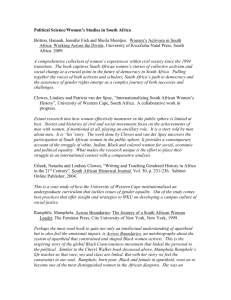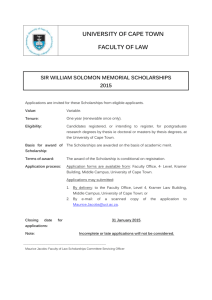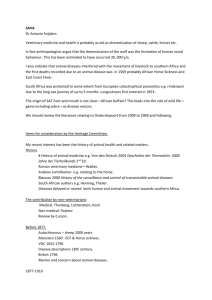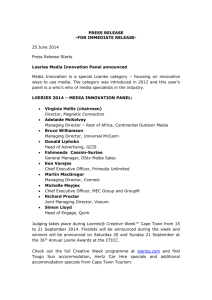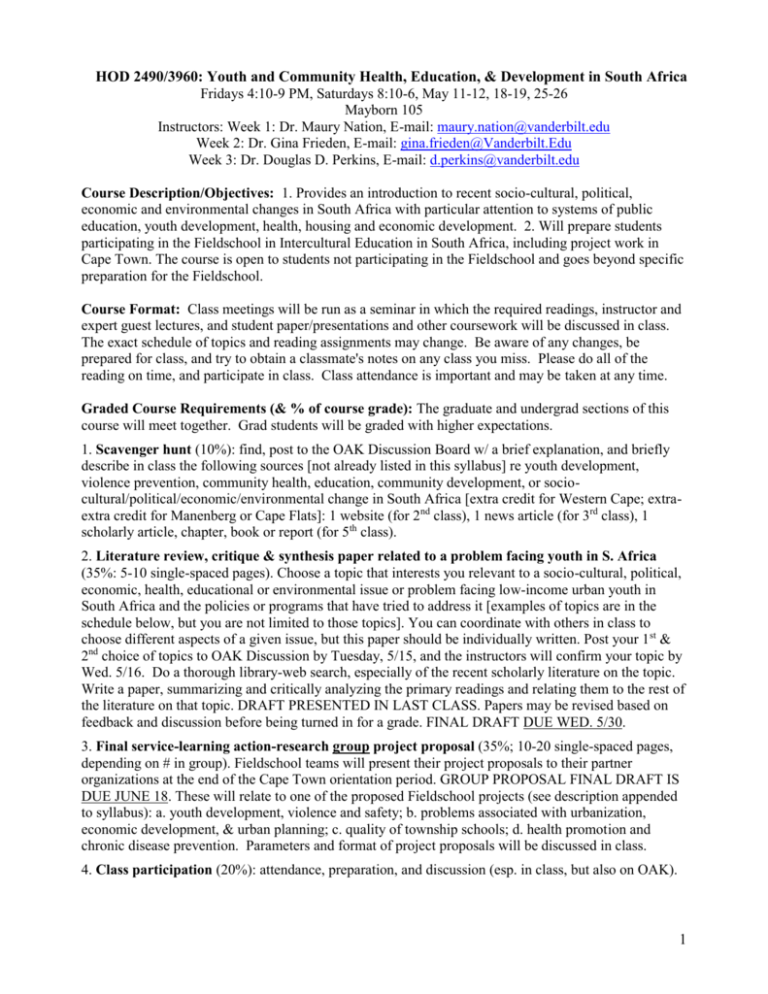
HOD 2490/3960: Youth and Community Health, Education, & Development in South Africa
Fridays 4:10-9 PM, Saturdays 8:10-6, May 11-12, 18-19, 25-26
Mayborn 105
Instructors: Week 1: Dr. Maury Nation, E-mail: maury.nation@vanderbilt.edu
Week 2: Dr. Gina Frieden, E-mail: gina.frieden@Vanderbilt.Edu
Week 3: Dr. Douglas D. Perkins, E-mail: d.perkins@vanderbilt.edu
Course Description/Objectives: 1. Provides an introduction to recent socio-cultural, political,
economic and environmental changes in South Africa with particular attention to systems of public
education, youth development, health, housing and economic development. 2. Will prepare students
participating in the Fieldschool in Intercultural Education in South Africa, including project work in
Cape Town. The course is open to students not participating in the Fieldschool and goes beyond specific
preparation for the Fieldschool.
Course Format: Class meetings will be run as a seminar in which the required readings, instructor and
expert guest lectures, and student paper/presentations and other coursework will be discussed in class.
The exact schedule of topics and reading assignments may change. Be aware of any changes, be
prepared for class, and try to obtain a classmate's notes on any class you miss. Please do all of the
reading on time, and participate in class. Class attendance is important and may be taken at any time.
Graded Course Requirements (& % of course grade): The graduate and undergrad sections of this
course will meet together. Grad students will be graded with higher expectations.
1. Scavenger hunt (10%): find, post to the OAK Discussion Board w/ a brief explanation, and briefly
describe in class the following sources [not already listed in this syllabus] re youth development,
violence prevention, community health, education, community development, or sociocultural/political/economic/environmental change in South Africa [extra credit for Western Cape; extraextra credit for Manenberg or Cape Flats]: 1 website (for 2nd class), 1 news article (for 3rd class), 1
scholarly article, chapter, book or report (for 5th class).
2. Literature review, critique & synthesis paper related to a problem facing youth in S. Africa
(35%: 5-10 single-spaced pages). Choose a topic that interests you relevant to a socio-cultural, political,
economic, health, educational or environmental issue or problem facing low-income urban youth in
South Africa and the policies or programs that have tried to address it [examples of topics are in the
schedule below, but you are not limited to those topics]. You can coordinate with others in class to
choose different aspects of a given issue, but this paper should be individually written. Post your 1st &
2nd choice of topics to OAK Discussion by Tuesday, 5/15, and the instructors will confirm your topic by
Wed. 5/16. Do a thorough library-web search, especially of the recent scholarly literature on the topic.
Write a paper, summarizing and critically analyzing the primary readings and relating them to the rest of
the literature on that topic. DRAFT PRESENTED IN LAST CLASS. Papers may be revised based on
feedback and discussion before being turned in for a grade. FINAL DRAFT DUE WED. 5/30.
3. Final service-learning action-research group project proposal (35%; 10-20 single-spaced pages,
depending on # in group). Fieldschool teams will present their project proposals to their partner
organizations at the end of the Cape Town orientation period. GROUP PROPOSAL FINAL DRAFT IS
DUE JUNE 18. These will relate to one of the proposed Fieldschool projects (see description appended
to syllabus): a. youth development, violence and safety; b. problems associated with urbanization,
economic development, & urban planning; c. quality of township schools; d. health promotion and
chronic disease prevention. Parameters and format of project proposals will be discussed in class.
4. Class participation (20%): attendance, preparation, and discussion (esp. in class, but also on OAK).
1
SCHEDULE OF TOPICS & READINGS
Session. Topic/Readings
1. Syllabus, readings, requirements; Summer Field School
Overview of South Africa geography, race, history, economic, social, political change;
Western Cape Region; Cape Town and Cape Flats
Required Reading:
Ross, R. (2009). A concise history of South Africa. New York: Cambridge University Press.
Bornman, E. (2011). Patterns of intergroup attitudes in South Africa after 1994.
International Journal of Intercultural Relations, 35, 729-748.
Duncan, N. (2003). ‘Race’ talk: Discourses on ‘race’ and racial difference. International
Journal of Intercultural Relations, 27, 135-156.
Moller, V., & Radloff, S. (2010). Monitoring perceptions of social progress and pride of place
in a South African Community. Applied Research in Quality of Life, 5, 49-71.
Fuller, Alexandra. (June 2010). Mandela's children: South Africa is a vibrant, multiethnic
democracy striving, with mixed success, to fulfill its promise. National Geographic. 217.6
p. 80.
Commey, P. (June, 2009). Finally it's Zuma, but what lies ahead? New African, 10-14.
Thomas, H. (Nov., 2003). Bridging the divide. Property week Supplement, 4-9.
Commey, P. (Feb. 2007). South Africa: Oprah to the rescue? New African, 10-15.
Other Recommended [future] Readings:
Bhana, A., Petersen, I., & Rochat, T. (2007). Community psychology in South Africa. In S. M.
Reich, M. Riemer, I. Prilleltensky & M. Montero (Eds.), International community
psychology: History and theories. New York: Springer.
Clark, L. N., & Worger, H. W. (2004). South Africa: The rise and fall of apartheid. Harlow, UK:
Pearson/Longman.
Duncan, N., van Niekerk, A., de la Rey, C., & Seedat, M. (Eds.). (2001). 'Race', racism, knowledge
production and psychology in South Africa. Hauppauge, NY: Nova Science Publishers.
Jansen, J. D. (2009). Knowledge in the Blood: Confronting Race and the Apartheid Past: Stanford
University Press.
Peet, R. (2002). Ideology, Discourse, and the Geography of Hegemony: From Socialist to
Neoliberal Development in Postapartheid South Africa. Antipode, 34(1), 54-84.
Seedat, M., Duncan, N., & Lazarus, S. (Eds.). (2001). Community psychology: Theory, method and
practice: South African and other perspectives. Cape Town, SA: Oxford University Press.
Seekings, J. (2008). 'Just Deserts': Race, Class and Distributive Justice in Post-Apartheid South
Africa. Journal of Southern African Studies, 34(1), 39-60.
2. Youth development, violence and victimization in South African townships
Required Reading:
Bray, R., Gooskens, I., Moses, S., Kahn, L., & Seekings, J. (2010). Growing up in the new
South Africa: Childhood and adolescence in post-apartheid Cape Town. Cape Town:
HSRC Press.
Gevers, A. & Flisher. A.J. (2012). School based youth violence prevention interventions. In
Ward, C. L., Merwe, A. v. d., & Dawes, A. (Eds.). Youth violence: Sources and solutions
in South Africa. (p.175-209). Cape Town: University of Cape Town Press.
2
Makiwane, M., & Kwizera, S. (2009). Youth and well-being: A South African case study.
Social Indicators Research, 91, 223-242.
Petersen, I., Swartz, L., Bhana, A., & Flisher, A.J. (2010). Mental health promotion initiatives
for children and youth in contexts of poverty: The case of South Africa. Health
Promotion International, 25, 331-341.
Wegner, L. & Caldwell, L. (2012). Interventions for out-of-school contexts. In Ward, C. L.,
Merwe, A. v. d., & Dawes, A. (Eds.). Youth violence: Sources and solutions in South
Africa. (p.213-239). Cape Town: University of Cape Town Press.
Recommended:
Barbarin, O. A., & Richter, L. (2001). Economic status, community danger and psychological
problems among South African children. Childhood: A Global Journal of Child Research,
8(1), 115-133.
Barbarin, O. A., Richter, L., de Wet, T., & Wachtel, A. (1998). Ironic trends in the transition to
peace: Criminal violence supplants political violence in terrorizing South African Blacks.
Peace and Conflict: Journal of Peace Psychology, 4(3), 283-305.
Barbarin, O. A., Richter, L., & deWet, T. (2001). Exposure to violence, coping resources, and
psychological adjustment of South African children. American Journal of Orthopsychiatry,
71(1), 16-25.
Richter, L., & Dawes, A. (2008). A history of South African psychological research on child
development. In C. van Ommen & D. Painter (Eds.), Interiors: A history of Psychology in
South Africa (pp. 286-223). Pretoria: UNISA Press.
South African Police Service (2010). Murder in RSA for April to March 2003/2004 to 2009/2010.
Retrieved October 21, 2010 at:
http://www.saps.gov.za/statistics/reports/crimestats/2010/categories/murder.pdf
Stevens, G., Seedat, M., Swart, T. M., & van der Walt, C. (2003). Promoting Methodological
Pluralism, Theoretical Diversity and Interdisciplinarity Through a Multi-Leveled Violence
Prevention Initiative in South Africa. Journal of Prevention and Intervention in the
Community, 25, 11-29.
Stuijt, A. (2009). Gang rape: A youth cult in South African townships. Digital Journal, available at:
http://www.digitaljournal.com/article/264956
United Nations Office on Drugs and Crime (UNODC, 2009). South Africa: Proudly Manenberg.
Available online at: http://www.unodc.org/newsletter/en/perspectives/no02/page006.html
Ward, C. L., Merwe, A. v. d., & Dawes, A. (Eds.). (2012). Youth violence: Sources and solutions in
South Africa. Cape Town: University of Cape Town Press.
3.a. Challenges of South African Township schools
Guest speaker: Dr. Brian Heuser, Peabody Dept. of Leadership, Policy & Org.
Required reading (NOTE: YOU WILL BE QUIZZED ON THE FIRST 2):
Fiske, E. B., & Ladd, H. F. (2004). Elusive Equity: Education Reform in Post-Apartheid South
Africa.: Brookings Institution Press. (Intro: pp. 1-16).
The Economist (Jan 21, 2012). Education in South Africa: Still dysfunctional--Standards still
leave a lot to be desired.
Barbarin, O. A., & Richter, L. (1999). Adversity and psychosocial competence of South
African children. American Journal of Orthopsychiatry, 69(3), 319-327.
Greenberg, M.T., Weissberg, R.P., O’Brien, M.U., Zins, J.E., Fredericks, L., Resnik, H., Elias,
M.J. (2003). Enhancing school-based prevention and youth development through
3
coordinated social, emotional, and academic learning. American Psychologist. 58(6/7),
466-474.
CASEL. (n.d.) How evidence-based social and emotional learning programs work to produce
greater student success in school and life. Collaborative for Academic, Social, and
Emotional Learning. Retrieved May 3, 2012 at: http://casel.org/wpcontent/uploads/2B_Performance.pdf.
Recommended readings:
Brown, K. (2006). "New" educational injustices in the "new" South Africa: A call for justice in the
form of vertical equity. Journal of Educational Administration, 44(5), 509-519.
Carrim, N. (1998). Anti-racism and the 'new' South African educational order. Cambridge Journal
of Education, 28(3), 301-320.
Soudien, C. (1998) 'We know why we're here': The experience of African children in a 'coloured'
school in Cape Town, South Africa'. Race Ethnicity and Education, 1(1), 7-30
Dutton, S., Singer, J., & Devlin, A. (1998). Racial identity of children in integrated, predominantly
white, and black schools. The Journal of Social Psychology, 138(1), 41-53.
Hill, L. D., Baxen, J., Craig, A. T., & Namakula, H. (2012). Citizenship, Social Justice, and
Evolving Conceptions of Access to Education in South Africa: Implications for Research.
Review of Research in Education, 36, 239-260.
http://rre.sagepub.com.proxy.library.vanderbilt.edu/content/36/1/239.full.pdf+html
SouthAfrica.info (2006). Education in South Africa. Retrieved online, October 21, 2010 at:
http://www.southafrica.info/about/education/education.htm
Ngonyama ka Sigogo, T., Hooper, M., Long, C., Lykes, M. B., Wilson, K., & Zietkiewicz, E.
(2004). Chasing Rainbow Notions: Enacting Community Psychology in the Classroom and
Beyond in Post-1994 South Africa. American Journal of Community Psychology, 33(1-2),
77-89.
Explore UNESCO website: www.unesco.org/ ; NORRAG website: http://www.norrag.org/ ; &
Room to Read: http://www.roomtoread.org/programs/index.html
3.b. Applied Qualitative & Quantitative Research Methods (needs assessment, program
evaluation, ethnography, naturalistic & participant-observation, open & semi-structured
interviewing, surveys, social indicators, etc.)
Guest presentation by Prof. Marybeth Shinn on Need Assessment
Recommended readings:
Babbie, E. R. (1990). Survey research methods (2nd ed.). Belmont, CA: Wadsworth.
Banfield, G. (2004). What’s really wrong with ethnography? International Education Journal, 4(4),
53-63.
Berk, R. A., & Rossi, P. H. (1999). Thinking about program evaluation (2nd ed.). Sage.
Gmelch, G., & Gmelch, S. (1999). An ethnographic field school: What students do and learn.
Anthropology and Education Quarterly, 30(2), 220-227.
Hirsch, P., & Lloyd, K. (2005). Real and virtual experiences learning on the Mekong: Field schools,
e-Sims, and cultural challenge. Journal of geography in higher education, 29(3), 321.
Hines, A. M. (1993). Linking qualitative and quantitative methods in cross-cultural survey research:
Techniques from cognitive science. American Journal of Community Psychology. Special
Issue: Culturally anchored methodology, 21(6), 729-746.
Jackson, J. (2006). Ethnographic preparation for short-term study and residence in the target culture.
International Journal of Intercultural Relations, 30(1), 77-98.
4
Krueger, R.A., & Casey, M.A. (2000). Chapter 1: Overview of focus groups. Chapter2: Planning
the focus group study. In Focus Groups (3rdEdition) (pp. 3-37). Thousand Oaks, CA: Sage.
Neuber, K. A. (1980). Needs assessment: a model for community planning. Beverly Hills, CA:
Sage. + SKIM the following link which contains sample community needs assessment
surveys: South Nashville Community Needs & Assets Assessment
Rossi, P.H., Wright, J.D., & Anderson, A.B. (1983). Handbook of survey research. Academic Press.
4.a. Cultural competency
Guest presentation by Prof. Marshall Eakin re cultural competency in service-learning
Required Reading:
Milner, H.R. (2010). A Diversity and Opportunity Gaps Explanatory Framework. In Start
where you are but don’t stay there: Understanding diversity, opportunity gaps, and
teaching in today’s classrooms (pp 13-44). Cambridge: Harvard Education Press.
Heppner, P.P., Aegisdottir, S., Leung, S.A., Duan, C., Helms, J.E., Gerstein, L.H., & Pedersen,
P.B. (2009). The intersection of multicultural and cross national movements in the
United States: A complementary role to promote culturally sensitive research, training,
and practice. In Gerstein, L.H., Heppner, P. P, Egisdottir, S., Leung, S. A., &
Norsworthy, K.L. (Ed.). International handbook of cross-cultural counseling: Cultural
assumptions and practices worldwide. (p. 33-52). Los Angeles: Sage.
Naidoo, A.V. and Kagee, A. (2009). The quest for relevance: Counseling psychology in South
Africa. In Gerstein, L.H., Heppner, P. P, Egisdottir, S., Leung, S. A., & Norsworthy,
K.L. (Ed.). International handbook of cross-cultural counseling: Cultural assumptions
and practices worldwide. (p. 421-433). Los Angeles: Sage.
Rohleder, P., Swartz, L., Carolissen, R., Bozalek, V., & Leibowitz, B. (2008). "Communities
isn't just about trees and shops": Students from two South African universities engage
in dialogue about 'community' and 'community work'. Journal of Community and
Applied Social Psychology, 18(3), 253-267.
Recommended readings:
Duncan, N., & Bowman, B. (2009). Liberating South African psychology: The legacy of racism and
the pursuit of representative knowledge production. In M. Montero & C. C. Sonn (Eds.),
Psychology of liberation (pp. 93 – 114). New York: Springer.
Landis, D., Bennett, J., & Bennett, M. (Eds.)(2004). Handbook of intercultural training (3rd ed.).
Sage.
4.b. Epidemiology & community health promotion
Possible guest speaker [via videoconference from Cape Town]: Dr. Linda-Gail Bekker,
Desmond Tutu HIV Centre & UCT Institute of Infectious Disease & Molecular Medicine
Required Reading:
Boon, H., Ruiter, R.A.C., James, S., van den Borne, B., Williams, E., & Reddy, P. (2009, Nov).
Correlates of grief among older adults caring for children and grandchildren as a
consequence of HIV and AIDS in South Africa. Journal of Aging Health, 22(48), 48-67.
Bradshaw, T., Mairs, H., & Richards, D. (2006). Developing mental health education for
health volunteers in a township in South Africa. Primary Health Care Research and
Development, 7, p. 95-105.
Drenth, C.M., Herbst, A.G., Strydom, H. (2010, Jul). A complicated grief intervention model.
Health SA Gesondheid, 15(1), Art. #415, DOI: 10.4102/hsag.v15i1.415.
5
Harrison, A., Newell, M.-L., Imrie, J., & Hoddinott, G. (2010). HIV prevention for South
African youth: which interventions work? A systematic review of current evidence.
BMC Public Health, 10, 102.
Nglazi, M.E., van Schaik, N., Kranzer, K., Lawn, S.D., Wood, R., & Bekker, L. (2012). An
incentivized HIV counseling and testing program targeting hard-to-reach unemployed
men in Cape Town, South Africa. Journal of Acquired Immune Deficiency Syndrome.
59(3), 28-34.
Recommended readings:
Campbell, C., Nair, Y., & Maimane, S. (2007). Building contexts that support effective community
responses to HIV/AIDS: A South African case study. American Journal of Community
Psychology, 39(3-4), 347-363.
Cornish, F., & Campbell, C. (2009). The Social Conditions for Successful Peer Education: A
Comparison of Two HIV Prevention Programs Run by Sex Workers in India and South
Africa. American Journal of Community Psychology, 44(1-2), 123-135.
Eaton, L., Flisher, A. J., & Aaro, L. E. (2003). Unsafe sexual behaviour in South African youth.
Social Science and Medicine, 56(1), 149-165.
Floyd, L. J., Heden, S., Lawson, A., Salama, C., Moleko, A. G., & Latimer, W. (2010). The
association between poly-substance use, coping, and sex trade among Black South African
substance users. Substance Use & Misuse, 45(12), 1971-1987.
Hunter, M. (2007). The changing political economy of sex in South Africa: The significance of
unemployment and inequalities to the scale of the AIDS pandemic. Social Science &
Medicine, 64, 689–700.
Kalichman et al. (2006). Associations of poverty, substance use, and HIV transmission risk
behaviors in three South African communities. Social Science & Medicine, 62, 1641–1649.
Parry, C. D. H., Carney, T., Petersen, P., Dewing, S., Needle, R. (2009). HIV-risk behavior among
injecting or non-injecting drug users in Cape Town, Pretoria, and Durban, South Africa.
Substance Use & Misuse, 44(6), 886-904.
Parry, C., Dewing, S., Petersen, P., Carney, T., Needle, R., Kroeger, K., & Treger, L. (2009). Rapid
assessment of HIV risk behavior in drug using sex workers in three cities in South Africa.
AIDS & Behavior, 13(5), 849-859.
Pronyk, P. M., Harpham, T., Morison, L. A., Hargreaves, J. R., Kim, J. C., Phetla, G., et al. (2008).
Is social capital associated with HIV risk in rural South Africa? Social Science and
Medicine, 66(9), 1999-2010.
Setswe, G. (2009). The HIV and AIDS epidemics in South Africa: Where are we? Paper presented
at the Academy for Educational Development workshop. Pretoria, SA: Human Sciences
Research Council. Retrieved 10/21/10 at:
http://www.hsrc.ac.za/research/output/outputDocuments/5890_Setswe_HIVandAIDSepidemicinSA.pdf
UNAIDS (2009). AIDS epidemic update 2009: Sub-Saharan Africa: Latest epidemiological trends.
Retrieved October 21, 2010 at: http://data.unaids.org/pub/FactSheet/2009/20091124_FS_SSA_en.pdf
5. Urbanization, Housing, Economic Development, Planning and Youth/Citizen Participation
Required Readings:
Pikholz, L. (1997). Managing Politics and Storytelling: Meeting the Challenge of Upgrading
Informal Housing in South Africa. Habitat International, 21(4), 377-396.
Charman, A., Petersen, L., & Piper, L. (2011). Spaza shops in Delft: the changing face of
township entrepreneurship (Working paper #6). Cape Town, South Africa: Sustainable
Livelihoods Foundation & African Centre for Citizenship & Democracy.
6
Kruger, J. S., & Chawla, L. (2002). “We know something someone doesn’t know”: Children
speak out on local conditions in Johannesburg. Environment & Urbanization, 14(2), 8596.
Swart-Kruger, J., & Chawla, L. (2002). Children show the way: Participatory programs for
children of South African streets and squatter camps. In M. Tienda & W. J. Wilson
(Eds.), Youth in Cities: A Cross-National Perspective (pp. 31-57). New York: Cambridge
University Press.
Moses, S. (2006, September 4-6). An Overview of Children’s Participation in South Africa.
Paper presented at the Theorising Children’s Participation Seminar, University of
Edinburgh, Scotland.
Whitehead, K. A., Kriel, A. J., & Richter, L. M. (2005). Barriers to Conducting a Community
Mobilization Intervention among Youth in a Rural South African Community. Journal
of Community Psychology, 33(3), 253-259.
Recommended Readings:
Baccaro, L., & Papadakis, K. (2009). The downside of participatory-deliberative public
administration. Socio-Economic Review, 7(2), 245-276.
Baumann, T., Bolnick, J., & Mitlin, D. (2004). The age of cities and organizations of the urban
poor: The work of the South African Homeless People's Federation. In D. Mitlin & D.
Satterthwaite (Eds.), Empowering Squatter Citizen: Local Government, Civil Society, and
Urban Poverty Reduction (pp. 193-215). Earthscan
Charman, A., & Piper, L. (2011). Conflict and cohesion in the informal economy: a reassessment of
the mobilisation of xenophobic violence in the case of spaza shops in Delft South, Cape
Town, S. Africa. Sustainable Livelihoods Fndn.
Griesel, R.D., Swart Kruger, J., & Chawla, L. (2002). "Children in South Africa can make a
difference": An assess-ment of "Growing Up in Cities" in Johannesburg. Childhood: A
Global Journal of Child Research, 9, 83-100.
Fraser, A. (2007). Land reform in South Africa & the colonial present. Social & Cultural
Geography, 8, 835-851.
Friedmann, J. (1992). Empowerment: The politics of alternative development.
Hester, R. T. (1984). Planning neighborhood space with people. Van Nostrand Reinhold.
Huchzermeyer, M. (2009). Enumeration as a Grassroot Tool Towards Securing Tenure in Slums:
Insights from Kisumu, Kenya. Urban Forum, 20(3), 271-292.
Kim et al (2007). Understanding the impact of a microfinance-based intervention on women’s
empowerment and the reduction of intimate partner violence in South Africa. Am. J. of
Public Health, 97(10), 1794-1802.
Murray, J.M. (2009). Fire and ice: Unnatural disasters and the disposable urban poor in postapartheid Johannesburg. International Journal of Urban & Regional Research, 33, 165-192.
Parliamentary Monitoring Group (2009). Minister of economic development on income inequality
in South Africa. Retrieved online, October 21, 2010 at: http://www.pmg.org.za/print/18568 .
Peet, R. (2002). Ideology, Discourse, and the Geography of Hegemony: From Socialist to
Neoliberal Development in Postapartheid South Africa. Antipode, 34(1), 54-84.
Perkins et al. (2004). Community development as a response to community-level adversity:
Ecological theory & research & strengths-based policy. In Investing in children, youth,
families & communities: Strengths-based research & policy. APA.
Pronyk et al. (2008). Can social capital be intentionally generated? A randomized trial from rural
South Africa. Social Science & Medicine, 67, 1559–1570.
7
Simon, D. (2003). Contextualising South African Local Economic Development within Current
Development Debates: The International Setting. Urban Forum, 14(2-3), 127-146.
Thomas, L. (2006). Social capital and mental health of women living in informal settlements in
Durban, South Africa, and Lusaka, Zambia. In K. McKenzie & T. Harpham (Eds.), Social
capital and mental health (pp. 124-137).
Webster, E. (2005). Making a Living, Earning a Living: Work and Employment in Southern Africa.
International Political Science Review, 26(1), 55-71.
6. International education and Fieldschool Model; Logistics of travel, study/volunteering/
research abroad (NGOs, government, universities, entrée, contacts, permissions);
Conclusions; present & discuss student research papers
Guest speaker: Cathy Arendse, Hubert Humphrey Fellow, re life, culture, and government
systems in S.A.
Required readings:
Hansen, H. M. (2002). Defining international education. New Directions for Higher Education,
2002(117), 5-12.
Robinson, J., & Perkins, D. D. (2009). Social development needs assessment in China: Lessons
from an international collaborative field school in Guangxi Zhuang Autonomous
Region. China Journal of Social Work, 2(1), 34-51.
+ read as needed re the topic & methodology of your likely project work (see below)
South Africa Fieldschool in Intercultural Education in Youth & Community Development:
Group Project Abroad Short Term Seminar Project
A group of 16 students in the course will participate in a 42-day intercultural fieldschool project in
South Africa (SA) for 15 advanced undergraduate, masters and doctoral students planning careers in
K-12 or post-secondary teaching or school counseling, plus one project director and two codirectors (one of which will be cost-shared by Vanderbilt University). We will use the project to
develop our fieldschool program into a more systematic model for international collaborative fieldbased training in community studies and, more generally, in area studies, community health, and
applied social research. Our goal is to incorporate international applied community studies more
fully into our higher education curricula. The success and sustainability of the above goal is
contingent upon our ability to develop a long-term relationship with our prospective international
partners. Thus, the proposed 2011 fieldschool will (1) build the foundation of those long-term
relationships (2) develop and disseminate our curriculum related to the international fieldschool
program, and (3) provide real-world collaborative foreign field project experience and learning for a
group of American and South African students and faculty.
Toward those aims, students, supervised by faculty, of the Departments of Human and
Organizational Development (HOD) at Vanderbilt’s Peabody College of Education and Human
Development and of Psychology at the University of Cape Town (UCT), SA, will participate in one
of four collaborative short-term service-learning projects, in partnership with one UCT-sponsored
organization and four local non-governmental organizations working in the mixed-race township of
Manenberg, near Cape Town, SA. These five service organizations have expressed the need and
willingness to collaborate with American students and scholars during a previous visit to Cape
Town by one of the co-directors of the proposed grant. Vanderbilt has already established a strong,
8
multi-faceted relationship and official cooperative agreement with UCT; and we have identified
multiple HOD faculty with an interest in developing and maintaining future academic ties there.
The overarching theme of the service-learning projects is the promotion of wellbeing, safety, and
justice through youth and community development projects in South African townships.
Participating students and faculty will gain a better understanding and appreciation of complex
human developmental, sociocultural, political, economic and environmental/planning issues, which
are poorly understood, particularly by Western scholars. The four service-learning projects will
focus on (1) youth development in a high-crime, low-income township, (2) housing and
neighborhood conditions and needs, especially for youth, (3) understanding and improving
community health promotion efforts to prevent HIV and other chronic and infectious diseases, and
(4) quality and challenges of South African township schools. We will select students based on a
combination of their potential for a successful, high-impact career in international education and
their ability to contribute to the project areas above.
The first week in Cape Town consists of orientation tours and presentations on South African
culture, history, politics, development issues and the work of the five partner organizations. Weeks
2-4 will focus on the above township project work. Students will report to UCT and organizational
partners on what they have learned and achieved in week 5. For the last 7 days of the six-week
period abroad, the group will tour historical, educational, and cultural sites in Pretoria,
Johannesburg, and either Bloemfontein or Durban. Following the trip, we plan to disseminate both
the fieldschool model and any collaborative project results in academic publications, conferences
and other presentations to inform educators and students at the local and national levels.
9




